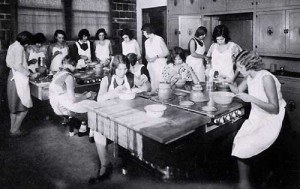The history of Home Economics can be traced well over 150 years ago. One of the first to champion the economics of running a home was Catherine Beecher. (sister to Harriet Beecher Stowe) Catherine and Harriet both were leaders in the mid 1800s in talking about domestic science. They came from a very religious family that valued education especially for women.
The Morrill act of 1862 propelled domestic science further ahead as land grant colleges sought to educate farm wives in running their households as their husbands were being educated in agricultural methods and processes. Iowa, Kansas, Nebraska, Illinois, Minnesota and Michigan were early leaders in offering programs for women. There were women graduates of these institutions several years before the Lake Placid Conferences which gave birth to home economics movement.
Up until the first Lake Placid Conference in 1889, much of the work in domestic sciences had not been documented. There were activities in the east surrounding the New England Kitchen and nutrition for the masses. Ellen Swallow Richards was instrumental in having her very own space at the World’s Fair in 1893 called the RUMFORD KITCHEN. This was after she refused to particpate in the demonstration kitchen in the Women’s Building. She said nutrition was not women’s work, but information for all.
Ellen and her contemporaries met at Lake Placid and other places over the next 10 years, each year exploring the latest in advances in the profession. Their goal was to form an education and scientific association as a necesary component in formalizing the profession.
In January 1909, the American Home Economics Association was formed. This name held until 1993 when a group of modern home economists met in Scottsdale, Arizona to chart the course for home economics in the new millennium. Upon the recommendation of the Scottsdale Conference, the name was changed to the Amercian Association of Family and Consumer Sciences.
Long before the Scottsdale meeting, many colleges and universities had changed their names to such titles as Human Sciences, Human Ecology, Consumer and Family Sciences just to name a few. The new names sought to better position the profession within the academic communities and to further illustrate the actual majors in the profession. While this naming benefited many in the higher educational arena, the failure to have just one name continued to errode the focus of the profession and fragmented any brand recognition for the profession.
Today, 100 years after the founding of the professional organization, family and consumer sciences professionals continue to practice in many venues including secondary teaching, college and university teaching and research and outreach through cooperative extension programs. Many practice in the human services areas working with children and elderly and all in between. Nutritionists, consumer specialists and housing and textiles specialists continue to provide for a better quality of life for individuals, famlilies and communities.
While there are some who hold the position that the profession has strayed far afield from the original founders’ intentions, the case can be made that in many cases khuyến mãi fun 88 , these professionals are right on target with the founders’ dreams. There is still much to be accomplished with nutrition and obesity issues, with elder care and gerontology in general, with living green issues and always work to be accomplished to improve people’s daily lives.
The next 100 years will challenge the best and the brightest in the profession to continue a leadership legacy that was begun over a century ago. Young students in colleges and universities are stepping up in remarkable ways to continue a legacy that lives today.
